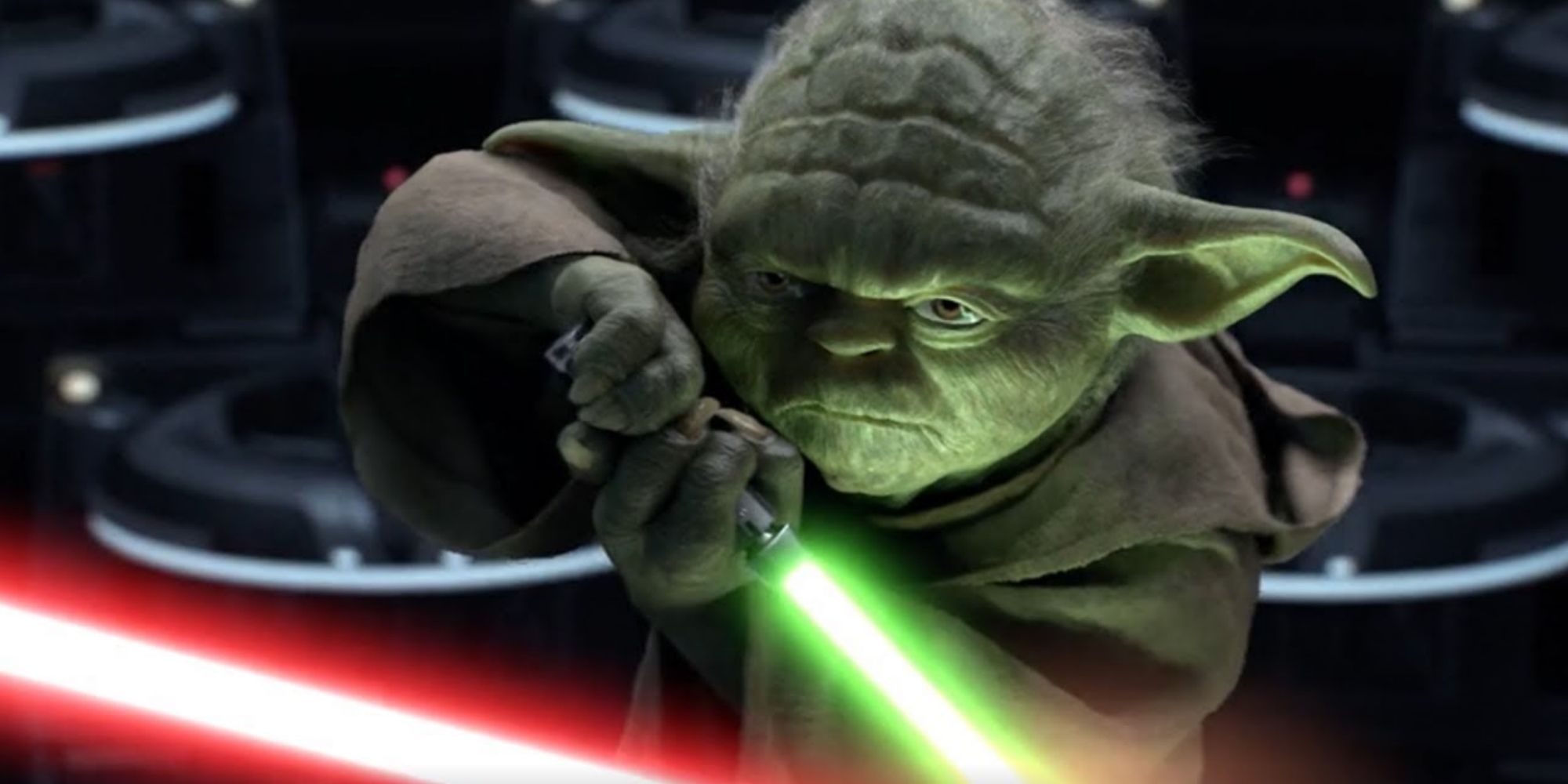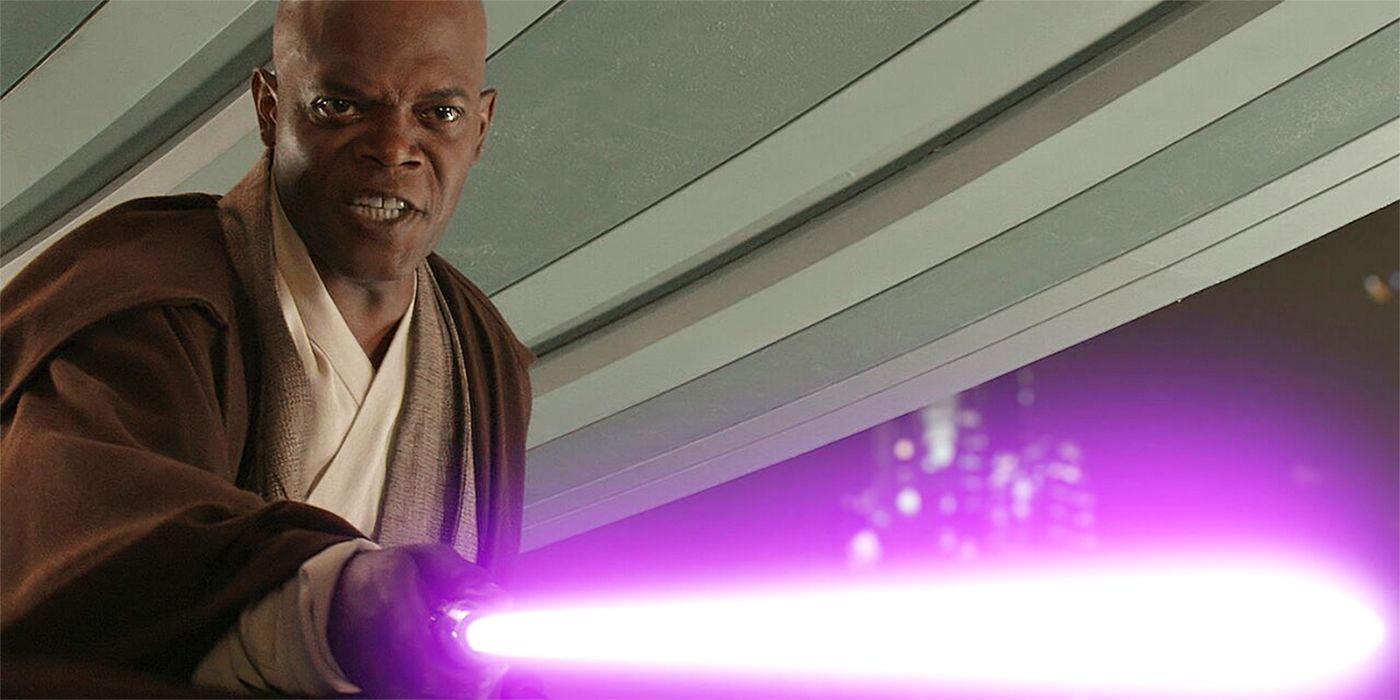The Big Picture
- Lightsaber colors used to indicate a Jedi's class and were restricted to blue, green, and yellow.
- Purple lightsabers represent mastery and complete control over the Force and can be used by both the light and dark side.
- Red lightsabers are a giveaway that the user is on the dark side and has embraced negative emotions associated with the Sith.
Does the color of a Jedi's lightsaber matter? It's a question that has plagued humanity since Obi-Wan Kenobi (Alec Guinness) handed over Anakin Skywalker's lightsaber to Luke (Mark Hamill) in 1977's Star Wars: Episode IV - A New Hope (or, at least, since you read the title of this article). Blue, green, yellow, red, black and — famously — purple are all lightsaber colors that have appeared throughout the Star Wars universe, in canon or otherwise. The short answer to whether or not the color matters is no, not really. The slightly longer answer is it used to — about 4,000 years before the Battle of Yavin, with a wider diversity of colors, including ones that haven't been seen to date, shown at their peak in The High Republic, which is set 200 years before the prequel trilogy. Truthfully, the most appropriate answer isn't necessarily tied solely to whether or not the color matters but includes what the color means. And that opens up a fascinating history.
Kyber Crystals Are the Heart of a Lightsaber
A little backstory: at the heart of every lightsaber are lightsaber crystals, also known as kyber crystals, that power the lightsaber and produce the powerful blade by resonating. The first and most common crystals were found in the Adega system, Ilum, or Dantooine. When these crystals were no longer easily attainable, the Jedi used various other crystals and gems, while those on the dark side of the Force favored the use of synthetic crystals, as confirmed by the canon reference book Star Wars: The Secrets of the Sith. There were no Duracell crystals, however, so the Jedi or Sith Lord making the lightsaber had to infuse the crystal with the Force, spending days on end meditating on the crystal to accomplish the task. Only then can it be placed into the hilt of the lightsaber, where it reacts to the owner and turns a specific color in tune with the user's Force energy.
Lightsaber Colors Indicated a Jedi's Class in the High Republic
In the days of 4,000 BBY, the color of a Jedi's lightsaber indicated a Jedi's chosen class and was restricted to one of three colors: blue, green, and yellow. Blue is the most prominent and was used to indicate the user was a Jedi Guardian, a Jedi highly skilled in lightsaber combat. The color itself was said to represent righteousness and bravery, virtues the Jedi stand for, which is why the color is so prevalent and so closely associated with the Jedi. A brief who's who of users with blue lightsabers includes Obi-Wan Kenobi, Luke Skywalker, Anakin Skywalker (Hayden Christensen, pre-youngling slayer), Shaak Ti, and Count Dooku (Christopher Lee, pre-dark side/ass handed to him by Yoda).
The green lightsaber indicated the user was a Jedi Consular. A Jedi Consular, although skilled in lightsaber combat, was more in tune with the mental aspects of the Force, choosing to reflect on its mysteries. Green is a reflection of harmony, helpfulness, cooperation, spirituality, and goodwill, and is most commonly associated with wiser, senior members of the Jedi Order. Not surprising, given that the Jedi we've seen using green lightsabers include Yoda (Frank Oz), Qui-Gon Jinn (Liam Neeson), Quinlan Vos, and a fully-trained Jedi Luke Skywalker.
Yellow is perhaps the most misunderstood of the original set. The color, when used in double-bladed lightsaber pikes, is exclusively used by Jedi Temple guards, either intentionally to distinguish them, or by the crystal choosing who should be a temple guard. The color's association isn't as clear-cut, with characters like Asajj Ventress, Ahsoka, Plo Koon, and in Legends, Wookie Jedi Master Tyvokka all having used a yellow-bladed lightsaber. A clue to what the color may indicate lies in Legends with the ancient Jedi Jaden Korr, who changed a lightsaber crystal from red to yellow by purifying it, pointing to the possibility it is synonymous with piety. Most recently, yellow happens to be the color of Rey Skywalker's (Daisy Ridley) lightsaber, as seen at the end of Star Wars: Episode IX - The Rise of Skywalker.
Lightsaber Colors Have Less Meaning in Current Star Wars Canon
You can thank Samuel L. Jackson for expanding the color spectrum of lightsabers, with his request that his prequel trilogy character, Mace Windu, have a purple lightsaber, for no other reason than he wanted to be able to find himself in the plethora of Jedi in the Geonosis arena, and he just really likes the color (picture the conversation between George Lucas and Jackson: "I want a purple lightsaber." "There are no purple lightsabers in Star Wars." "I'm Samuel L. Jackson, dammit." "Purple it is."). So the addition of purple lightsabers to the Star Wars canon meant creating a meaning behind the color, and as a result, purple has come to represent mastery and complete control over one's powers, with the ability to use both the light and dark Side of the Force without being seduced by the dark. Windu is the most notable Jedi with a purple lightsaber, but others have wielded one as well outside of canon. In Legends, this includes Han and Leia's daughter Jaina Solo, An'ya Juro, Ki-adi-Mundi, and Vernestra Rwoh, the youngest to hold the title of Jedi Knight at the age of 15.
There's more, of course. The Darksaber, introduced in The Clone Wars Episode "The Mandalore Plot", has a unique black blade, built by the first Mandalorian Jedi Tarre Vizsla. Ownership of the Darksaber came to be associated with the leadership of the clans of Mandalore, as we know from The Mandalorian series. It's been in the possession of Sabine Wren, Bo-Katan Kryze, Pre Vizsla, Din Djarin (Pedro Pascal), and — horrors — Moff Gideon (Giancarlo Esposito), who kept it as a prize after conquering Mandalore. Ahsoka Tano (Rosario Dawson), on the other hand, has white lightsabers, the byproduct of restoring special Kyber crystals, initially red, from the lightsaber of an Inquisitor. The white represents the fact that Ahsoka is autonomous, no longer a Jedi but with no affinity towards the dark side.
There are many, many more, especially in Legends: Silver (peace and purity), orange (energy, creativity, and ambition), magenta (charm, harmony, and compassion), bronze (maturity, connection to nature, and wisdom)... It's like one of those Facebook "Which color lightsaber are you?" quizzes that sends results back based on whether you see a monkey or a Wookie in a picture.
Red Lightsabers Always Indicate a Sith
So while the Jedi moved away from lightsaber colors designating class to personal preference and connection to the crystal, the Sith have not, with red lightsabers the giveaway that the user isn't planning on slicing bread with it. Unlike the Jedi, the Sith are unable to interact with kyber crystals, so they will steal one, kill a Jedi for one, or use a synthetic crystal. Once they have a crystal, that crystal is put through a "bleeding" process that gives it that reddish tint. Basically, all the nasty emotions that have come to be associated with the dark side — power, anger, hatred — are imparted into the crystal. A lightsaber belonging to a Jedi that has turned, like Darth Vader or Count Dooku, will only turn red when they fully embrace the dark side. With the Disney+ series The Acolyte on the horizon, we will likely get a chance to see how the red lightsaber came to be associated with the rise of the dark side.
All that said, even if a lightsaber color doesn't really matter all that much, the color can still say a lot about its creator. And in a way, that ends up mattering the most.



